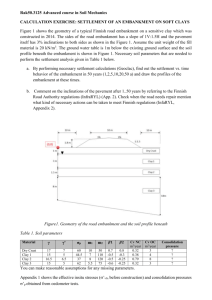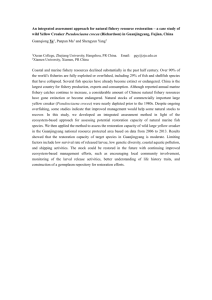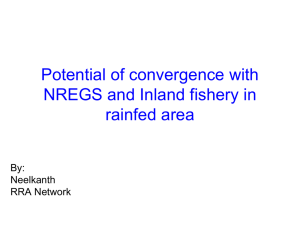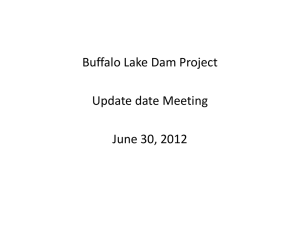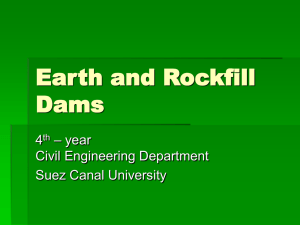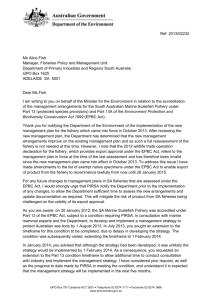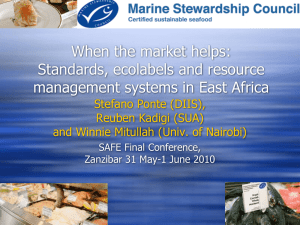Vulnerability from Embankment Damage in Indian Sundarbans: Recent
advertisement
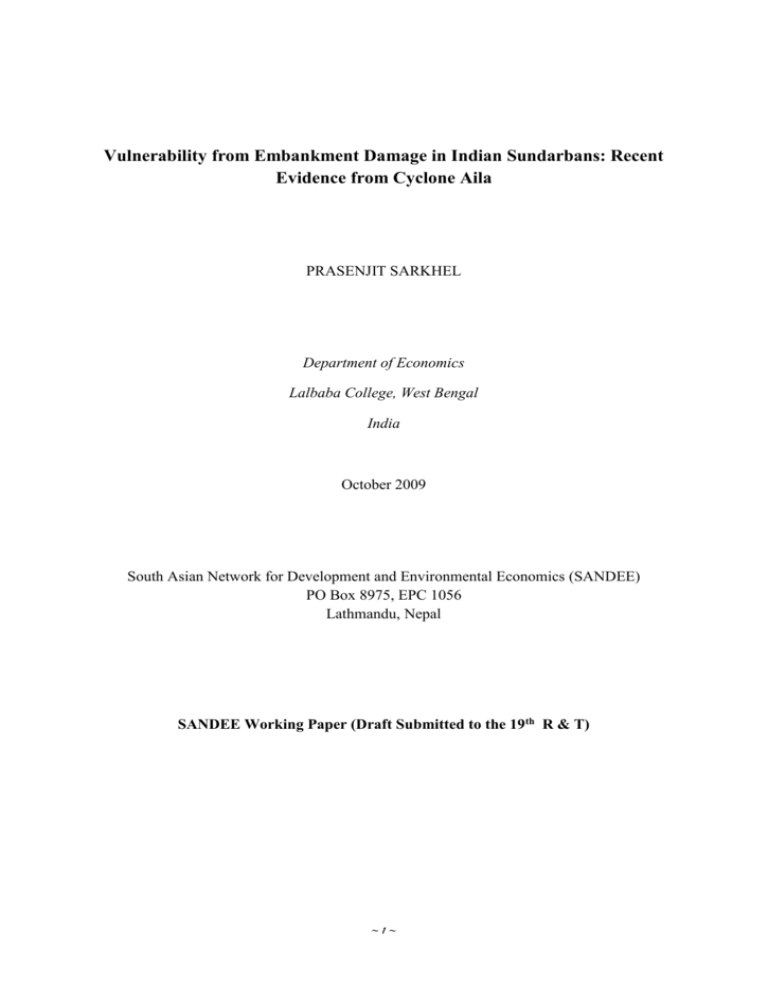
Vulnerability from Embankment Damage in Indian Sundarbans: Recent Evidence from Cyclone Aila PRASENJIT SARKHEL Department of Economics Lalbaba College, West Bengal India October 2009 South Asian Network for Development and Environmental Economics (SANDEE) PO Box 8975, EPC 1056 Lathmandu, Nepal SANDEE Working Paper (Draft Submitted to the 19th R & T) ~1~ TABLE OF CONTENT 1. INTRODUCTION 2. RIVER EMBANKMENTS AS PUBLIC GOODS: PROVISIONING OF EMBANKMENTS IN INDIAN SUNDARBANS 3. PRIVATE PARTICIPATION IN EMBANKMENT CONSERVATION 3.1 PRIVATE CONTRIBUTION TO PUBLIC GOOD :EXISTING LITERATURE 3.2 LANDUSE PATTERNS AND EMBANKMENTS IN SUNDARBANS 4. METHODS 4.1 HYPOTHESIS 4.2 THEORETICAL MODEL 4.3 ECONOMETRIC SPECIFICATION 5. STUDY AREA AND DATA 5.1 SAMPLING STRATEGY 5.2 DATA COLLECTION AND ANALYSIS 6. RESULTS AND DISCUSSION REFERENCES ANNEX 1- TABLES ANNEX 2-FIGURES ANNEX 3-QUESTIONNAIRE ~2~ TABLE OF TABLES Table 1: Table 2: Table 3: Table 4: Table 5: Table 6: Table 7: Table 8: Table 9: Table10: TABLE OF FIGURES Figure 1: Figure 2: Figure 3: Figure 4: Figure 5: Figure 6: Figure 7: Figure 8: Figure 9: Figure 10: ~3~ Abstract The Indian Sundarbans, lying south of Dampier-Hodges line, a habitat of 4.1 million people is prone to natural hazards like cyclones and flood. In recent times the incidence of cyclone Aila has inflicted enormous damage in this area in terms of loss of lives and assets. Till date flood protection in Sundarbans against tidal surges had been ensured by 3500 km long mud embankments erected since the colonial period. In the aftermath of Aila policy dialogues are centered on structural measures to strengthen the embankments but institutional reforms to ensure proper maintenance of the embankments has not received much attention. By analyzing the community institutions engaged in dyke maintenance in Sundarbans this paper attempts to fill this gap by suggesting ways to ensure greater community participation in embankment maintenance. This study identifies the factors that determine private expenditures towards embankment maintenance in Sundarbans and the institutional arrangements that ensures it by conducting a survey of………………………………………households in selected villages of two blocks of Indian Sundarbans, Sandeshkhali II and Basanti that has been affected in the recent catastrophe. Keywords: public good, collective action, natural disaster ~4~ Vulnerability from Embankment Damage in Sundarbans: Recent Evidence after Cyclone Aila Prasenjit Sarkhel 1. Introduction On 25th May, 2009 between 1330 to 1430 hours IST cyclone Aila made its landfall in the Sagar islands in Sundarbans with a wind speed of 100 -110 km/hour causing enormous damage to life and assets in West Bengal and Bangladesh. Almost .70 million people were affected and the economic damage were assessed to be around .36 million (INR) with death tolls of over 300 in West Bengal. The damage from disaster was most intense in Sundarbans part of West Bengal where almost 100000 people were rendered homeless and agricultural lands as well as aquaculture ponds were submerged in saline water for days. The damage in Sundarbans had been caused by breach and subsidence of the 3500 km long embankments erected in the colonial period (Richard and Flint,1990) to protect the cultivable lands from tidal ingress. The tidal surge fueled by Aila damaged almost 400 km of the existing dykes and the most immediate policy concern is the reconstruction of the embankments along with relief and rescue operations. The policy discourse focused entirely on the technological aspects of embankment reconstruction and engineering aspects like embankments made out of concrete or geo-textiles. At the same time the government is pondering over the modes of acquisition of land that would be required for the reconstruction of the dykes1. However, concern is expressed over the fact that a hefty sum of 600 million INR would be required for the project of which only 100 million would come as grant in aid from the Central Government. It is clear that embankment restoration would involve a substantial fixed cost but there are also issues of operating cost or cost of maintenance in the long run. Unless proper institutional arrangements are developed for embankment maintenance the project 1 According to the Department of Irrigation and Waterways there should be a distance of 80-90 meters between the river and the embankment where there would be tree cover (The Statesman, 15 June, 2009). Thus, rebuilding of existing embankments would surely involve displacement of the existing habitats. ~5~ expenditures may turn into sunk cost threatening the sustainability of the Sundarbans area. Public maintenance of the Sundarbans embankment is mostly carried out by the Department of Irrigation and Waterways though its role in regular maintenance, apart from major repair works, has been gradually phasing out in recent years. This happened due to the active involvement of the local bodies i.e. Panchayats in dyke patching through the funds available under the National Rural Employment Guarantee Scheme (NREGS). At the same time community involvement in embankment maintenance has varied in parts of Sundarbans according to pattern of land use, geographical location as well as extent of public intervention in dyke protection. Though paddy cultivation remained the dominant occupational pattern in Southern part of Sundarbans2 in the Northern part, there has been large scale transformation of paddy land to brackish water aquaculture farms3. For areas with large tracts of aquaculture farms, Irrigation and Waterways are reluctant to carry out mud patching as they think it is the onus of the fishery owners to take care of the embankments because they are using the adjoining sluice gates or in some cases extracting saline water by digging channels in public embankment structures. In response the aquaculture farm owners have evolved different institutional arrangements to contribute for the provisioning of the embankment in Sundarbans area. This observation is particularly important in the background of Aila stricken Sundarbans as paddy fields that have been inundated by saline flood waters have a high probability of getting transformed into aquaculture ponds4. Thus, brackish water fishery farms are likely to play a crucial role in the maintenance of the embankments especially in the backdrop of increasing tendency of the government for devolving the management of the embankments in the hands of communities. Identifying the determinants of private expenditures and efforts towards embankment management would inform policymakers about possible areas of intervention for strengthening community capacity towards reducing vulnerability from embankment damage. 2 The trend of land use is changing towards fishery activities in this part also (See Chopra et. al., 2004; Knowler et.al.2009). 3 Percentage utilization of the potential brackishwater area available in North 24 Parganas district is 30% as against 17.14% in south 24 Parganas district. 4 Existence of fishery farms itself increases the salinity of the soils and may affect paddy cultivation resulting thereby hastening the conversion process (Maheswari et. al. 2009). ~6~ 2. River Embankments as Public Good: Provisioning of Embankments in Sundarbans River embankments are a class of pure non excludable public goods and the benefits of its flood protection accrue to all and sundry. However, this also falls in the category of ‘weakest link public goods’ in that the total quantity available to each consumer is equal to the smallest contribution of the individual (Hirshleifer, 1983, 1984). Thus, the least maintained part of the dyke determines the welfare of the whole population. Cornes (1993) has shown that in case of these public goods heterogeneity of individuals in terms of income and preference trigger movement away from symmetric equilibrium and can result in under provision5. In such a situation there exists a strong incentive for the individuals to search for alternative institutional forms that would lead to Pareto improving allocation thereby gear Nash Equilibrium towards the social optimum6. This endogenous determination of institutional structure matches the situation perfectly in those areas of Sundarbans where the transformations of land into fishery ponds have attained maturity. There are three Irrigation Divisions that supervise the river embankments in Sundarbans area: Joynagar Irrigation division (covering roughly one third area of Sundarbans in the South 24 Parganas district including blocks like Basanti, Gosaba Mathurapur I and II, Joynagar I and II ,Canning I and II and parts of Patharpratima,Namkhana and Sagar),Kakdweep Irrigation division (covering the rest of Sundarbans namely Namkhana ,Kakdweep,Patharpratima and Sagar Block) while the whole of North 24 Pargana part of Sundarbans come under the Basirhat Irrigation Subdivision. All the three irrigation offices confirmed that except for emergency repairs they do not undertake any maintenance of the embankments that bounds the fishery plots. At the same time regular maintenance for the Sundarbans embankment has also been showing a falling trend since mid nineties (See Figure 1). Though initiation of NREGA (National Rural Employment Guarantee 5 In the weaker link version of the problem the production function of the public good is given by where is the total public good and is the contribution of the jth individual. Utility maximization subject to the budget constraint solves for q as a function of income and unit cost of provision. Thus, individual contribution depends on the preference parameter , income of the individual and the cost of provision and is likely to differ for heterogeneous agents. 6 See Cornes (1993, pp268-269). ~7~ Act) have actually devolved the right of embankment management on the community institution it would not be correct to link it with the gradual phasing out of government’s involvement in the management of river embankments in the Sundarban area. For one thing implementation of NREGA in West Bengal began in late 2006 while expenditures on regular maintenance of embankments has been falling sharply almost ten years before that. Moreover NREGS fund has other competing uses and only part of it is used for embankment maintenance7. The maintenance work by Panchayats is supposedly designed taking into account the historical shocks of embankment breaches from tidal ingress in Sundarbans. Shocks of larger magnitude like Aila were unprecedented and it precisely tore apart the vulnerable points that were already identified under NREGA scheme. Data regarding embankment damage (as length of embankments that subsided or were breached) was available for 70 Gram panchayats (GP) for 10 blocks of Sunadarbans in South 24 Parganas under the Jaynagar Irrigation division for the post Aila period. To investigate whether flood control works under NREGA had any impact in minimizing the damage, data regarding number of flood control works, labour expenditure and expenditure were gathered for the pre-Aila period i.e. 2008-09. To normalize the data, the damage length (EMD) was expressed in terms of the total area of the GP8 and the expenditure on flood control works is divided by the number of works undertaken (NREWK). Further, since land use is supposed determine the extent of public expenditure on embankments proportion of area not under cultivation (ANCL) is also included as an explanatory variable. This is supposed to capture whether there were damage differentials in predominantly fishery and non-fishery areas. To proxy for dependence on land the proportion of literates (PLI) among the total population is also included as an explanatory factor. Higher educational levels are supposed to cause outmigration in cities or engagement in non-farm employment thereby reducing commitment on the provision of resources for embankment conservation. The descriptive statistics of the variables are presented in Table 1. On an average in these 10 GP’s the length of embankment damaged is around 7 km the maximum damage 7 Other than flood control expenditures the fund under the NREGA is also used for rural connectivity,water conservation and water harvesting,renovation of traditional water bodies,drought proofing,Irrigation canals and provison of irrigation facilities to disadvantaged groups and land development. 8 Ideally the dependent variable should have been expressed as the proportion of embankment damage in the GP’s. Unfortunately, the total length of the embankments at the village level is not available with the Irrigation Department so it was proxied by the total area of the GP. ~8~ being done at Gosaba. Among the blocks Kulatli records the highest amount of NREGA expenditure per work in the pre-aila period but also have an above average breach figure for the 10 GP’s included in analysis. To understand the causal relationship better the following lin-log regression equation is then estimated9: …1 Note that in addition to the variables described block dummies were inserted in (1) to account for unobserved area specific characteristics. Table 2 reports the regression results. The regression results show that both NREGA work and education variable is directly related to the extent of embankment damage though the latter is not significant. The proxy for land use shows a negative sign but is statistically insignificant confirming the fact that Aila comprises of a systematic shock and its effect has spread in all areas. Among the block dummies those for Canning I and II were dropped from the final regression as they were statistically insignificant and this improved the model fit. Taking Basanti as the base the coefficients on block dummies reveal that only Panchayats in Gosaba recorded a higher than average breach in embankments. The result on NREGA needs cautious interpretation and at least it should not be taken as an indicator of the programme failure. Rather it points to the fact that NREGA targeting was proper in the sense that it was undertaken in vulnerable areas but only that it was not designed to take into account such low probability high consequence events. As such this phenomenon is not particular to West Bengal per se. Analyzing district level data in terms of flood intensity and area protected Gupta et. al. (2003) also finds the inadequacy of structural modes of flood protection like embankment strengthening in India. However, they did not use the actual subsidence and breach data and their analysis is much more aggregate at the district level. Even in its implementation period the proportion of fund in NREGS devolved for flood control projects varied across villages. Like the Department of Irrigation and 9 Several other specifications like log-log log-lin was tried but the reported equation provided the best fit. The Cooks-Weisberg test for Heteroskedasticity rejected the Null Hypothesis of constant variance at less than 5 percent level of significance. The reported estimates are White Heteroskedasticity corrected standard errors. ~9~ Waterways, scant investment in flood control projects took place in the brackish water fishery prone villages. In the post Aila situation precisely in these areas flood control investments were stepped up at a large scale. For instance, in case of Sandeshkhali-II block out of 8 GP’s flood control projects were undertaken during 2008-2009 in 3 GP’s of which the maximum number of flood control projects took place in two GP’s Khulna and Durgamondop that have no fishery activities at all and here agriculture is the dominant occupation10.It must be noted in caveat that NREGA flood control projects are demand driven where the Panchayats submits the work plan for the project so lack of flood control works may also be due to other administrative aspects that are not controlled for. It can, however, be confirmed from the reports of the Irrigation Department that these villages are not without incidence of embankment damages11. Mainly two types of damage occur during the high tide periods during July to October: slip and subsidence of the embankments and spilling of tidal waves over the embankments. If government response to the potential collapse of the embankments is inadequate one possibility is that village residents would organize and look after the resource either by pooling their own resource or by creating pressures on the local government for immediate action. 3. Private participation in Embankment Conservation 3.1 Private contribution to public good: existing literature The crucial determinants for collective action in local public good (such as embankments) provision problem would be both the absolute level of wealth and distribution of wealth (i.e. inequality), and the array of available exit options. For people with wealth below the threshold level collective action possibilities are nil (Bergstromet.al.1987). Here, a transfer from contributor to the noncontributing agent (i.e. those having lower asset holdings) may be useful on normative grounds but may 10 A total of 8 flood control projects were finalized out of which both Khulna and Durgamondop are to have 3 projects each and Bemajur I that has both fishery and agriculture would have only 1 project. However, other principally fishery dominated GP’s like Bermajur II, Atapur and Sandeshkhali did not have any projects at all. 11 The most recent one in the pre Aila period occurred on 17 September,2008 (http://www.expressindia.com/latest-news/rains-tidal-waves-hit-coastal-bengal-one-dead-hundredsaffected/362891/) ~ 10 ~ actually reduce the overall provision of public goods (Baland and Platteau, 2003)12. In the specific context of coastal embankments in Goa, Mukhopadhay (2005) precisely obtains this result. An otherwise egalitarian land transfer has resulted in lesser interest of traditional groups of big landholders for embankment maintenance providing disincentives for collective action. If the fixed cost of such infrastructure related public good is high and the benefit shares of all agents falls short of the threshold that is required for the public good to yield any benefit then there would be no voluntary investment. This Nash equilibrium corresponds to the phenomenon of co-ordination failure (Baland and Platteau, 2003). However, if the per unit cost of conservation is lower compared to the benefit accrued to the wealthier household such that their contribution is assured, small asset holders shall join suit if free riding benefits are low and the relative net benefit of collective behavior is lower than the unit cost of conservation activities (Baland and Platteau,1997). Private participation in local resource management can be explained in terms of three distinct phases of collective action: a) challenge to the status quo and proposal for collective action; b) choice problem of the stakeholders between cooperation and noncooperation and c) the emergence and evolution of collective action as a result of individual’s decision in b) (White and Runge, 1995). For instance, the study by White and Runge (1995) about local watershed management in Haiti observes that the initiation of collective action came through a nongovernmental organization Save the Children Federation (SCF).Similarly the Joint Vertisol Project (JPV) discussed in Gaspert et. al. (1997) and Water User Association in Dick et. al. (2002) played a crucial role in the formation of community awareness in Watershed development in Ethiopia and Irrigation Canal management in India respectively. In the second stage socio economic factors like land holdings, capital/labour endowment, type of yield from land, availability of exit options and leadership variables like membership in peasant associations were found to be the important determinants of cooperative behavior. However, the emergence of collective outcome and its sustenance largely depends on whether the joint outcome is supported by private Nash Equilibrium (Baland and Platteau, 1997). There are instances where the cooperative outcome fails because coordination failure. Agents may indulge in Pareto inferior behavior if there 12 However, Ghosh and Karaivanov (2007) shows that if all agents are homogenous such reduction in public good provision in presence of increase in alternative income can actually reduce welfare. ~ 11 ~ is absence of credible commitment for others to undertake a collective rational outcome. In a synthesis, Agarwal (2001) lists a number of factors such as a) resource characteristics - well defined boundaries, b) group characteristics - shared norms, heterogeneity of endowments but homogeneity of identity and interests, c) Institutional arrangements -locally devised management rules and ease in enforcement and finally d) external environment involving governments aid and recognition to the local group that are conducive to the sustenance of collective action in particular. In the specific case of Sundarban areas the extent of private participation in embankment conservation can be analyzed by considering strategic interdependence of the agents benefiting from flood protection. As such given the level of public action that has been the patch works by irrigation department and recent flood control schemes under NREGA one can identify three types of agent interaction for supplementing public projects with private expenditure. The first arises where the villages have entirely agricultural plots near the embankments. The second type of village is where major land use is fishery and in the third case we identify villages there is a mix of fishery and agricultural plots. In each of these villages the incentive to participate in embankment protection is likely to differ as here the level of government involvement varies according to land use and property rights over land are different. To be more specific there is an active lease market or secondary market in case of fishery lands. Here, individuals trade lands without formal legal procedure and this informal contract in production also has a bearing on the extent of expenditures or efforts incurred by the land owners in maintaining the nearby embankments. Thus, in order to gain a proper understanding of the relation ships between land ownership and embankment maintenance a brief discussion of the evolution of land rights and its dynamics warrants a discussion 3.2 Land Use patterns and Embankments: A brief account of Sundarbans The 3500 km long embankments that serve as the major defense against tidal intrusion in Sundarbans were set up by the initial settlers during the colonial period. The property right of these embankments was vested in the hands of zamindars that made the tenant farmers responsible for its maintenance and repair. Thus, the incentive to maintain the embankments were largely associated with potential of crop ~ 12 ~ damage from saline ingress and the consequent fear of disentitlement from tilling rights once they fail to pay their rental obligations. After independence the Government of West Bengal took over the onus of repair and maintenance of the mud embankments and in due course of time it changed hands from the Land Revenue Department to the Department of Irrigation and Waterways. In rural West Bengal the land reform programme ‘Operation Barga’ was initiated in 1978 and thereafter the share croppers (bargadars) were ensured the legal protection against eviction by the landlords, and entitled them to the due share of the produce. The thrust in agricultural activities were short lived in Northern part of Sundarbans as shrimp farming offered a more profitable venture compared to mono cropping practices. Thus, outside capital owners leased in land from small peasants in the river side and previously distributed land holdings again amalgamated to form large tracts of fishery farms. As the fishery operators were outsiders over time non-payment of lease and neglect of embankments became a pressing problem and from the late nineties the villagers themselves started operating the fishery farms on their own13. However, as the fishery farms on large lands were redistributed again the fishery operations were generally organized under a committee formed out of the landholders in the same tract of plot. Most of these fisheries drew water from the sluice gates of dig canals across the landholdings but there are others who dug pipes in the embankments to channelize brackish water in their ponds. The operation and maintenance of the sluice gates, canals and embankments henceforth became the responsibility of the committee or the individuals who used pipes to bring in saline tidal water. Apart from the sudden shocks of embankment collapse one recurrent idiosyncratic shock that threatened the fishery activities for the past few years in these areas is one of virus infection of the fishes. The fishery owners incurred huge loss due to the fish disease and here in the third phase of land transformation has started to occur. The phenomenon is in its inception but is visible in many parts of North Parganas: fishery fields being converted in to brick kilns. Paradoxically, the fishery fields are again leased out to outside capitalists against a higher lease rate and longer tenure that what it was in case of aquaculture lands. The tendency has accentuated even more after Aila.The community participation in embankment management hence, needs to be examined in 13 However, the lease market for land did exist and now it changed hand frequently among local villagers. ~ 13 ~ this background taking into account all the factors that affects the benefits and cost of embankment conservation. (To be updated with suitable references; specific management practices in Bangladesh and Netherlands to be discussed in this context) 4. Methods 4.1 Hypotheses The following hypotheses were formulated: Hypotheses I: The net benefits of private expenditure for embankment conservation is higher for households with brackish water aquaculture farms as compared to agricultural households; Hypothesis II : The private expenditure for embankment maintenance among fishery farms varies according to farm size, land ownership status, exposure to random shocks of high probability like virus attacks and shocks like embankment breaches etc. and public intervention in dyke preservation; Hypothesis III: The institutional arrangements for embankment maintenance is contingent on farm specific characteristics like source of brackish water, land arrangements as well as group and village specific characteristics. 4.2 Theoretical Framework Individual contribution to embankment maintenance is likely to depend on the expected loss when the embankment breach takes place under usual tidal surge. Unless accompanied by easterly winds such breaches are idiosyncratic in nature in that affects the plots that are closer to the river in Sundarbans. Hence, those living closer to the river embankments have the maximum incentive to undertake maintenance work. In primarily agricultural areas there may be two reasons why under provisioning in terms of private investment occur: first habit formation of receiving public assistance in case of breach events and irregular but public maintenance activities from NREGA fund and Irrigation department. Secondly comparatively low returns in agriculture may have increased the opportunity cost of regular maintenance. Places where there are both fisheries and agriculture the location of the plots as well as government inaction provide incentives for undertaking mud patching expenditures in dyke maintenance. This is because typically for ease of water withdrawal the riverside plots gets converted to fisheries pushing the ~ 14 ~ agricultural plots at the centre or the periphery of the village. The same logic applies for fishery prone areas also. Moreover, these plots in almost all cases evade the license from Aquaculture authority (and don’t have a legal standing of the agricultural plots such as ryoti and patta) and so no question of government compensation arises in case there are possibilities of tidal inundation. The higher expected loss (of higher returns) from fishery business is another factor that drives the maintenance activities in this part of Sundarbans. However, the portion of embankment used for fishery purpose may be tied to more than one land where large number of plots draws water from a single source (hence forth referred as many plot-single source, MS). In the eventuality of embankment collapse all these plots get affected and so for them the total amount of embankment protection obtained is a function of the sum of individual contribution. For single plot –single source (henceforth SS) system the embankment is much like the private good: the flood protection benefit is a function of his own contribution. Assume that the utility function of the typical individual is described as .... (1), where flood protection benefit, the numeraire is good is the total is the public provision of embankment and is given and is the individual contribution for embankment conservation. The individual maximizes (1) subject to the budget constraint … (2),where income from fishery farm and is the unit cost of conservation and is the is the wealth endowment. …. (3) In the MS case the individual solves for Typically then individual contribution in this case depends on income, wealth, cost poof provisioning and the contribution by other members. The last term also incorporates the free riding concept in the form of non-contribution. In the SS case we obtain … (3) ~ 15 ~ To capture the relation ship between public and /or private investment assume that ….14(4) Then the individual contribution can be solved as: ….. (5) Consider then the following cases Predominantly agricultural village the observed non-contribution is possible if Assuming no other people contribute, complete non-contribution by an individual is ensured if government conservation expenditure covers his total income and wealth endowment. The MS case and finally, The SS case Thus, evidently 14 . See Cornes (1993,p-263) ~ 16 ~ Apart from the extreme case of zero contribution to what extent the effort of agricultural falls short of (or may even exceed) the contributions of the fishery farms would depend on the relative magnitude of public intervention vis-à-vis private contribution of the fishery owners. (The case of non-cooperation so that contribution becomes zero in the MS case to be updated) 4.3 Econometric Specification The regression equation for estimating private contribution to embankment maintenance is ….. (1) Expenditure on conservation can be typically measured as the total wage bill paid to labourers; in case of family labour the prevailing wage rate can be imputed. This is so because in Sundarbans hiring labour for mud patching is common and due wageemployment scheme of the NREGA wage rate has been fixed in the labour market. One can also consider the cost of material for embankment patching but generally the only thing used here is mud from the near by plots and river silts and so its cost can be over looked. The data regarding income can be obtained as the yield rate of land under both agriculture or fishery and the past sales record. While present value of household’s fixed asset can be an indicator of his wealth, amount of land holding can stand for both wealth and income. The variable stands for system dummy and can be used to capture village level fixed effects. However, since information regarding NREGA flood control works is available the government intervention can be included in the regression as the population average. Then finally specific characteristics. 5. Study Area and Data 5.1 Sampling Plan ~ 17 ~ includes the fishery farm To assess the differences in contribution in embankment conservation among fishery and non fishery households we decided to sample Panchayts from two blocks in Sundarbans : Sandeshkhali II in North 24 Parganas and Basanti from South 24 Parganas. From these two blocks we selected 10 villages: 7 from Sandeshkhali II and 3 from Basanti15. Both of these blocks are reported to have large tracts of aquaculture farms. Land use information in the Census 2001 is available at the village level but it does not specify how much of the land is actually used for brackish water aquaculture. Hence two proxies were taken for village selection: proportion of cultivators to main workers and proportion of land not available for cultivation. Though the latter is an aggregative measure in the sense that it may include forests as well land under water we did not have any data on land that is used for non-agricultural purposes. Moreover in the selected villages there is no forest cover. Thus typically a low percentage of cultivators to main workers and higher proportion of land not used for cultivation may indicate higher prevalence of aquaculture activities16. Later we also rechecked with the Sundraban officials to confirm whether these areas have substantial fishery activities. The characteristics of the villages are reported in Table 3. Going by our criterion Dhamakhali has the highest concentration of non-agricultural activities while Sitalia has the lowest in Sandeshkhali II block but the latter has the highest concentration of agricultural labourers. Literacy levels are less than 50 percent in three out of seven selected villages namely: Atapur,Bermajur and Jhupkhali. In Basanti Ramchandrakhali has the highest concentration of non-agricultural activites while that in Sachiakhali is the lowest. Except for Masjidbati the other two villages have literacy rates less than 50 percent. The villages in Bermajur I and II Gram Panchayat are bounded by the Boro Kalagachi River while those in Monipur and Khulna face the former along with the River Raimangal (See Map 1). Aila inflicted heavy damage in all these villages with maximum damage being inflicted in Atapur and Khulna. In fact, repair works of Irrigation were more or less complete in the other villages two weeks after the cyclone while only 67 percent and 5 percent of the total breach could be closed in Atapur and Sitalia (See Table 4). (Description of Basanti to be added) 15 There are 8 Gram Panchyats in Sandeshkhali II block out of which villages were selected from 4. In Basanti there are 13 Gram Panchayats out of which villages were taken from 3. 16 The correlation coefficient between proportional of area not available for cultivation and proportion of other workers to main workers and proportion of cultivators to main workers is significantly negative and positive respectively. ~ 18 ~ From the chosen villages in consultation with the village informants like Panchayat members we identified 50 households from each village from the voter list according to occupational categories: fishery and agriculture. For villages with a mix of fishery and agriculture the fishery households are oversampled according to the proportion of each activites as reported by the Panchayat. Further within the fishery group we selected households according to the source of brackishwater (i.e. SS or MS). 5.2 Data Collection and Analysis Two types of data have been collected: secondary data regarding actual damage report of the embankments due to Aila at the village level and primary data of the sampled households in Sundarbans. The analysis of the available secondary data till date has been reported in Section 2. Prior to the occurrence of Aila a pilot study of 50 households were undertaken with the revised questionnaire. The occurrence of Aila necessitated a few supplement to the questionnaire regarding change in land use, work and employment pattern, wealth changes and involvement of the occupational groups in embankment restoration. The main survey in the first phase covered 150 households in all the 7 villages of Sandeshkhali II block. The questionnaire generated data at two levels: household level information such as, demographic and socio-economic parameters like household size, occupation, sources of income like-farm income non farm income,religion,caste etc. and secondly plot level information for each households. This second set damage on each plot, expenditures undertaken, and amount of loss in monetary terms from embankment damage -all information the Panchayat maintenance in the form of frequency of embankment repair is also recorded. The preliminary findings of the survey using only the plot level information is discussed below (The discussion is based on a quick estimate as the data cleaning procedure is not yet complete. Number of questionnaires had to be refilled due to missing observations and this delayed the data entry procedure. Till date 130 household questionnaires had been entered but needs more screening). 6. Results and Discussion ~ 19 ~ The results discussed here are based on 130 household level information and 188 plot level observations out of which there are 122 fishery plots and 66 agricultural plots17.The summary statistics of the two types of plot: fishery and agriculture, at the village level is shown in Table 5. The plot holdings of the fishery households are greater than agricultural households in fishery dominated villages (Bermajur, Dhamakhali, Jhupkhali, Rampur, Dwarirjungle) than in principally agricultural village (Atapur and Sitalia). Moreover in the villages with mixed fishery and agricultural plots the distance of the agricultural plots from the embankments are greater than that of fishery plots supporting the dynamics of land transformation mechanism discussed earlier18. However, no clear pattern emerges with respect to incidence of embankment damage differentials in the two types of plot experienced in the past three years across villages. The same applies for the frequency of the operational plot getting affected by tidal inundation for the last three years. The descriptive statistics of the fishery plots according to the source of brackish water is presented in Table 6. The areas of the SS (i.e. drawing water from the river directly in their own plot) type fisheries are less than that of MS (i.e. where the source of brackish water is shared by other plot holders) type plots. The difference is however not statistically significant. The total expenditure on embankment protection for both types of fisheries are defined as follows: in the survey the fishery households are asked the amount of family and hired labour days they had spent in the past one year before Aila for embankment maintenance . The information about the wage paid to the hired labour was also collected. Assuming that the opportunity cost of the family labour is the wage rate for the hired labour the total wage bill for embankment maintenance was obtained as the sum of family wages bill and hired labour wage bill. To this amount the household’s monetary contribution to fishery committee for the last year is added 17 Other recorded plot use like sweet water fishery, orchard, brick fields etc. from our initial analysis. Together with this the plot level observation comes to 249. 18 The t-test of equality of mean distance for the agricultural and fishery plots from the embankment rejected the Null Hypotheis against the alternative hypothesis of distance for agricultural fields greater than fishery fields at less than 1 percent level of significance only for the village groups Dhamakhali,Jhupkhali,Rampur and Dwarirjungle. Though Bermajur has both fishery and agricultural fields such relationships are not statistically confirmed. In this connection it may be noted that fishery activities have a longer history and larger preponderance in the Dhamakhali village group than Bermajur. ~ 20 ~ if he belongs to one. This gives the total expenditure per year for an individual for embankment conservation. However, in this initial estimate we did not include the present value of land that the individual may have donated to the committee along with others for leasing out. The total expenditure per year for the SS type fisheries is significantly larger than that of MS type fisheries corroborating our model results19. The possible reasons could be the fact that number of breaches in embankments experienced by the SS type fisheries is significantly greater than the MS type fisheries. Also added to this the number of public intervention in the embankment of SS type fisheries is greater than that of MS type fisheries necessitating higher expenditure. One crucial determinant of conservation expenditure discussed above would be the exposure of the fishery owners to idiosyncratic shocks like virus infection of fishes. In fact, during field survey this was identified as an important determinant of profitability in fishery business. The incidence of virus infection recurrently plagues the fishery farms in this part of Sundarbans and its loss potential may increase the opportunity cost of other mitigation expenditures. Further, village level fixed effects like the state of infrastructure; activism of the Panchayats towards flood protection may also influence the individual level of expenditures undertaken. To estimate the conservation expenditure it must be noted that there are a lot of zero observations as not all fishery owners undertake investment expenditures on embankments. Thus, for the estimation procedure a Tobit model seems appropriate. The estimates of the Tobit model are reported in Table 7. Note that instead of taking the total expenditure as the dependent variable we have normalized it by the total area of the fishery plot. The regression results show that initially expenditure of embankments is directly related to exposure of virus attacks and embankment problems but increasing levels of virus attacks reduces the amount committed for embankment maintenance. Next, the level of flood protection provided by public agencies i.e. the Irrigation department is directly related to the expenditure. This is likely because the Irrigation department mostly carries out the immediate repair works 19 The t-test for equality of means of total expenditure across SS and MS type fisheries reject the NullHypotheis against the alternative hypothesis of SS type expenditures being greater than MS type at less than 5 percent level of significance. ~ 21 ~ in these areas and given the uncertainty of its availability further maintenance work may be necessary to minimize potential damage cost. The coefficient on the square of the public intervention term is negative but not significant and hence the crowding out effect cannot be confirmed at this stage. Finally the coefficient on source of brackish water is positive reiterating our claim that SS type fisheries incur more expenditure on embankments compared to MS type fisheries. The village dummies are all positive but only that of Dhamakhali, Dwarirjungal and Rampur are significant. The model provided good overall fit in terms of the chi2 but the pseudo R square is quite low and hence the specification issues are to be investigated further. ~ 22 ~ Appendix Table 1 : Embankment Damage and NREGA Expenditure for Jaynagar Irrigation Division –Summary Statistics Block (N=No. of Gram Panchayats) Subsidence & Breach length (m)After Aila as on 25th May NREGA per work expenditure in 200809(Rs. Lakhs) Area not under Cultivation (hectares) Proportion of literates to Total Population Basanti (N=11) Canning I (N=3) Canning II (N=2) Gosaba (N=12) Kulatali (N=7) Mathurapur II (N=7) Namkhana (N=6) Patharpratima (N=13) Sagar (N=8) Total (N=70) 5854.545 (3491.88) 7326.667 (9652.074) 3000 (2828.427) 13425 (7505.528) 9125.714 (6239.668) 5088.857 (5862.555) 2783.333 (1790.717) 4441.923 (3586.58) 1065.625 (1230.242) 6278.886 (6144.275) .099 (.255) .353 (.315) 0 .318 (.175) .370 (.212) .21 (.136) .262 (.136) .267 (.135) .021 (.016) .220 (.017) .250 (.199) .407 (.133) .261 (.170) .481 (.057) .564 (.102) .39 (.049) .57 (.04) .496 (.098) .565 (.043) .664 (.020) .620 (.026) .656 (.055) .571 (.087) .102 (.265) 1.158706 (.331) .231 (.350) .347 (.360) .584 (.326) .007 (022) .330 (.433) Notes: Figures in parentheses shows standard deviation. Source: Embankment Damage report from the Jaynagar Irrigation Department, NREGA website for the expenditure data nrega.nic.in and census 2001. ~ 23 ~ Table 2 : Estimates of Embankment Damage from Aila on25th May, 2009 Variable Ln ANCL Coefficients -.00021 (.0001) Ln PLI .00039 (.0003) Ln NREWK .00039** (.0001) D_GOSABA .00031** (.00013) D_KULTALI -.00025** (.00014) D_MATHURAPUR -.00034** (.00016) D_NAMKHANA -.00051*** (.00016) D_PATHARPRATIMA -.00049*** (.00015) D_SAGAR -.00042*** (.00013) CONSTANT .00072 (.00028) N=70,F(9,60)=21.39***,R2=.63,Root MSE=.00021 Note: ANCL: area not under cultivation (hectares), PLI: proportion of literates in the total population of GP,NREWK: NREGA expenditure per unit of flood control works. ~ 24 ~ Table 3: Characteristics of the sampled village District/Blocks Gram Panchayat Villages SC/P ST/P L/P MW/TW CUL/MW ALAB/MW (%) (%) (%) (%) (%) (%) South 24 Pgs/ Chunakhali Sachea Khali 12.58 19.88 42.86 71.21 34.89 56.02 BASANTI Ramchandrakhali Ramchandrakhali 21.72 4.82 41.42 74.58 20.00 41.89 Masjidbati Mazidbari 68.58 0.00 65.90 56.64 32.10 24.83 ALL VILLAGE AVERAGE 38.62 6.27 46.34 68.76 35.33 38.47 North 24 Pgs/ Bermajur II Dhamakhali 1.20 16.58 49.34 93.83 9.06 16.53 Sandeshkhali Bermajur II Jhupkhali 21.05 23.54 42.14 61.74 32.23 46.18 II Bermajur I Bermajur 28.20 22.65 45.31 56.62 31.73 42.89 Bermajur II Rampur 20.70 8.84 49.38 83.44 12.14 33.98 Sandeshkhali Dwarirjungle 38.43 35.96 52.59 60.57 27.43 37.09 Monipur Atapur 23.19 34.59 47.50 60.97 38.77 25.42 Khulna Sitalia 61.87 15.78 54.14 70.79 26.57 52.14 ALL VILLAGE AVERAGE 44.65 22.16 49.77 61.76 28.39 41.66 Notes : SC: Schedule Caste,ST: Scheduled Tribes,L:Total Literate population ,P:Total Population,MW: Main worker,PANCL:percentage area not available for cultivation. CUL:Cultivators,ALAB:Agricultural Labour,OTH:Other Workers (%:percentage of population) Source: Census 2001 Table 4: Progress of work under Basirhat Irrigation Division after Aila as on 11.06.2009 Mouja Dhamakhali Bermajur Rampur Jhupkhali Dwarirjungle Atapur Sitalia Block Sandeshkhali II Sandeshkhali II Sandeshkhali II Sandeshkhali II Sandeshkhali II Sandeshkhali II Sandeshkhali II Source: Basirhat Irrigation Division, Office of the Executive Engineer ~ 25 ~ Work Progress Breach Closed Breach Closed Breach Closed 87 percent 37.75 percent 67 percent 5 percent OTH/MW (%) 8.58 27.91 23.63 18.91 69.15 14.42 15.12 42.06 22.08 23.48 16.28 19.1 PANCL (%) 22.93 35.59 42.37 33.15 77.25 57.08 56.69 64.33 67.06 47.29 41.28 48.26 Table 5: Summary Statistics of Plot Characteristics Villages/ Variables Bermajur Dhamakhali +Jhupkhali+Rampur+Dwarirjungal Fishery Agriculture 4.11 3.14 Atapur Sitalia Fishery Agriculture Fishery Agriculture Fishery AREA 3.54 1.41 2.1 10.54 0.00 (bigha) DIST(m) 1009.31 1297.467 671.232 1750 226 581.92 0.00 EMBK 1 2 .95 .8 .8 1 0.00 LAFF .5 .66 .91 1.2 .4 1 0.00 Notes: AREA:area of the plot in bigha,DIST(m):distance of the plot from the nearest embankment in meters,EBK:incidence of embankment breach in last three years,LAFF: no. of times plot area affected due to embankment problems in last three years. Source:Field Survey Table 6: Summary Statistics of Fishery Plot Characteristics Source of Brackishwater EMBK GOVT TOT_EXP AREA (Rs./yr) (bigha) SS 1.31 .63 2691.22 3.85 MS .78 .21 1297.52 5.89 Notes:,EBK:incidence of embankment breach in last three years, GOVT: number of public intervention in embankment maintenance in the last three years,TOT_EXP: Total expenditure of the household for embankment maintenance in the past 1 year prior to Aila, AREA:area of the plot in bigha. Source:Field Survey ~ 26 ~ Agriculture 2.37 181.83 .37 .37 Table 7: Tobit Estimates of private expenditure on embankments for Fishery Households Dependent Variable: Per area expenditure on embankment (Rs. /bigha) Independent Variable FVI Coefficients 3748.11 ** (2131.58) FVI_SQ -1365.08** (644.33) BWD 1384.56** (656.15) EMBK 1491.3** (598.62) PUB 4419.60** (2232.37) PUB_SQ -1396.62 (1047.94) D_BM 1911.83 (4156.91) D_DH 9880.44** (4131.55) D_DL 9318.682** (4267.23) D_JH 5341.00 (4264.91) D_RM 9325.722** (4248.54) CONS -13977.72** (4695.329) 2 N=99, LRchi2(11)=41.62***,pseudo-R =0.04,Log-likelihood=-476.5 Notes: FVI: frequency of virus attacks in the last three years, FVI_SQ: square of FVI, BWD: dummy variable for source of Brcakish water 1 for SS and 0 for MS, EMBK: number of embankment breach events experienced in last three years;PUB: public agency both Irrigation and/or NREGA maintenance of embankment in last three years,PUB_SQ: square of PUB;D_BM: village dummy for Bermajur,D_DH: village dummy for Dhamakhali;D_DL: village dummy for dwarirjungal;D_JH: village dummy for Jhupkhali;D_RM:village dummy for Rampur. ~ 27 ~ Figure 1: Investments in the urgent repair works in Sundarbans, Irrigation and Waterways Department. ~ 28 ~ Map 1: Sampled Villages in Sandeshkhali II block Notes: Green boxes show location of sampled villages ~ 29 ~ Map 2: Sample villages of Basanti Block Notes: Yellow boxes show sampled villages ~ 30 ~ Map 3: Selected study blocks in Indian Sundarbans Notes: red dots show selected blocks ~ 31 ~ Photo 1 : Embankment breach in Atapur after Aila-almost two weeks after! Source: Own Photo from field visits ~ 32 ~ Photo 2 : Embankment collapse in Dhamakhali after Aila (field visits with Panchayat members shown in the right) Source: Own photo from field visits ~ 33 ~ Photo 3 : Sitalia after Aila Source: Own field vists Photo 4: Their Agony-my compulsion-Sitalia two weeks after Aila ~ 34 ~ Source : Field Visits ~ 35 ~
